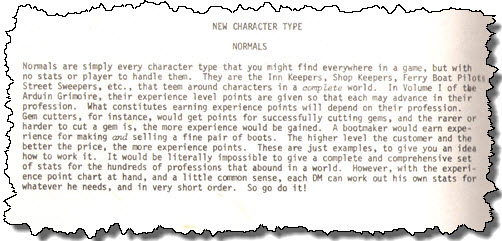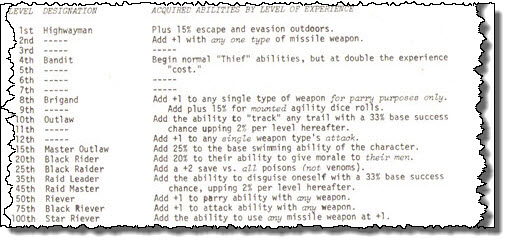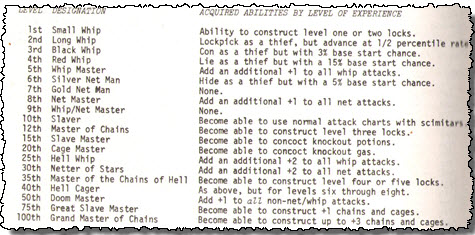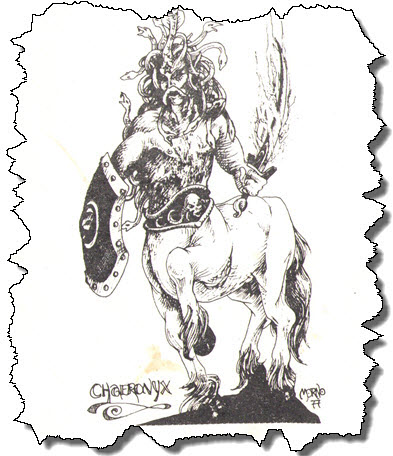Welcome To Skull Tower, Part IV
Welcome To Skull Tower, Part IV
Shopkeepers, Slavers, And Courtesans, Oh My!
(Did I Do The A, B, & C Thing In A Header Already? I Can’t Recall.)
(Well, Bugger It If I Have. You Ought To Know By Now I’ll Beat A Joke To Death, Reincarnate It, And Beat It Some More.)
(Yeah, But That’s Not A Joke, Even By Your Admittedly Overbroad Standards. At Best, It’s An Allusion.)
(So? My Favorite Character Was a Gnome Allusionist! See, That’s A Joke.)
(A Very Small One.)
(No, He Was Average Size For A Gnome)
(… I’m Outta Here.)
We (That’s the royal ‘we’, but I’m ‘murrican, and we don’t have no kings (‘ceptin’ Elvis and Kirby, so I guess it’s the Elected We) continue our walk through the classic Arduin trilogy of gaming supplements. More classes this time. Possibly something else, but it’s unlikely I’ll get that far. We’ll see. Hell, it’s possible I won’t even get through the classes.
But First, A Correction
I’d made a comment that there were no attribute-based bonuses to thief/martial artist skills, leaving the percentages exceptionally low. Well, I was wrong, for on the very next page, there’s a list of such modifiers. You get a +5% per each point OVER FOURTEEN (14) of the attributes in question, which is pretty straightforward for the era, and, also typical of the era, many use averages instead of a single attribute. For example, your bonus to Lie is Charisma and Intelligence… sorry, CHARISMA and INTELLIGENCE… “combined, then averaged”. Honestly, I sort of prefer this approach… or even a ‘variable attribute based on task’ approach… to the 3.x/Pathfinder system where attributes and skills are linked even for uses where there’s not always a perfect fit. On the other hand, I know people who really hate that kind of fussing over fine details of whether a particular task is more based on Intelligence or Dexterity. (The rules in Arduin continue to reference Agility, as well as Dexterity, so it seems it was a standard house rule in Dave’s games, one he assumed everyone played with.)
Also, Luck items add a flat +20% per plus, which, when you consider many of the odds start at 5% and go up by very small amounts per level, makes them extremely good to have.
Abby… Someone
One of the oldest debates in RPGs is the issue of whether normal people have levels. What, exactly, can a fifth level Candlemaker do that a fourth level one can’t? (Well, according to my homebrew rules, produce 0.45 more candles per hour, on average.) Dave included an XP chart for “Normals” in the Arduin Grimoire, but offered no guidelines on what that meant. He corrects that oversight in Welcome To Skull Tower. Sort of.
It’s good to know the real problem was the lack of an XP chart, and now that we’ve got that, everything else is easy.
Outlaws
Outlaws represent all manner of bandits, brigands, highwaymen, bikers, and so on. Like the martial artist, they’re intended to be used as a template to construct a particular type… also like the martial artist, the actual rules for differentiating types mechanically are pretty much non-existent, except for weapon choices. It’s interesting to note that it was understood, at the time, that a highly-customizable generic class was superior to a dozen or more specific classes that differed from each other only by a little, but no one had quite worked out how to do one, short of abandoning classes altogether, as Runequest (and others of the era) did.
- Outlaws use an 8 sided die (-1 point per die) for “experience points”. I sure hope they meant “hit points”.
- Outlaws wear light armor to facilitate fast getaways, and will not use halberds or other ‘encumbering’ weapons.
- Outlaws cannot have a Wisdom over 9, because it’s “not wise to flout the laws of the land”. It’s not wise to go crawling into forgotten tombs and abandoned castles, either, but no one puts that restriction on adventurers in general.
- Outlaws get XP for selling prisoners to Slavers, and loot to fences. They get 10 times as much XP for the prisoners as for the loot, but I guess gold and gems are more portable and less likely to escape and slit your throat (then again, this being the 1970s, the odds are good your gems and gold were actually monsters of some kind), so it all evens out.
As always, a few quick notes on the table:
- We start off with an all-too-common problem with the Arduin books… a bonus to a mechanic that doesn’t exist. There are no formal “escape and evasion” rules I know of from this time. I guess the DM can add 15% to whatever odds they decide on, or +3 if they’re using a D20, or tear their hair out if their “escape and evasion” rules are something like “escapes on 1-2 on a D6, unless pursued by elves, in which case, it’s a 1 on a D8, or if mounted, in which case, it’s a 5 or less on 2d6-2”, and, yes, we used to have a smeg-ton of mechanics like that…
- You get Weapon Focus (missile weapons only) as a bonus feat at second level. That’s cool.
- Thief abilities at “double the experience cost”? What does that mean? +1 effective Thief level for every 2 outlaw levels? Or was there a “spend XP to get abilities” rule that was lost forever? (Or to be found in future pages as I work through these, I guess…)
- +1 to any weapon for parry purposes only. There actually are parry rules on page 51 of the Grimoire. They’re confusing as all hell, but they’re there.
- Looking at the 50th and 100th(!) level abilities, it seems “useful with any weapon” was deemed far, far, better than “having a higher bonus with one weapon”. This must be that “bounded accuracy” thing D&D 5e is so big on.
- Tracking people through the woods is easier than putting on makeup. Who knew?
Special Politically Incorrect Class Section
Pearl-clutching Puritans, you’ve been warned.
Slavers (Not The Kind With Stasis Boxes)
(Though In Arduin, Anything Is Possible…)
Discussing This Class On RPG.Net Will Probably Get You Banned
Following the logic of the era, every profession (except ‘Normals’) gets their own class table. Let’s just take the usual disclaimers as to the immorality of the topic as given.
Slaver have a “cruelty factor” of “never less than 75%”, which means… erm… I dunno. The alignment chart in The Arduin Grimoire has “Cruelty Factor” along with Lie, Tolerance, and others, but it’s not remotely clear what to do with them. Does the DM roll them to determine if an NPC will or will not engage in some action? Do you roll both the “Kill Factor” and the “Cruelty Factor” to determine a)if the NPC will kill you, and b)if they’ll do it painfully?
Hobbits are only occasionally slavers, but, when they are, they’re among the cruelest. I do not find this surprising. Never trusted them furry footed little bastards.
Slavers fight “one column back” on the attack chart unless using nets or whips (well, duh) in which case, they get +2 and +4. When you consider that getting +1 with a single weapon type was considered a huge deal for outlaws, it’s clear there was little idea of ‘balance’ going on; Dave just wrote down whatever seemed cool, and the Arduin books are composed of rules and ideas from a span of several years, presented one after another without any evident editing of older items to bring them in-line with the newer stuff. It’s part of what makes them so awesome — they preserve the raw, original, thought processes of one of gaming most prolific and inventive creators, not the refined and “ready for press” results that have passed through several editors and co-authors. (A somewhat self-interested bit of praise, as these articles are dashed out in one pass without any real editing, either. I’m not lazy and sloppy… I’m sharing with you the raw purity of my creative instinct!)
Maybe if I win the lottery, I’ll buy the rights to Arduin and redo all of it in a massive tome under the OGL for 3.x/PF.
Of course, they gained abilities on a level-by-level basis…
- Does ‘as a thief’ mean ‘as a thief of the same level as the slaver’ or ‘as a thief of first level and then increment from here’?
- Man, compared to other classes, they really do pile on the net/whip bonuses, don’t they?
- Earlier rules cover the idea of trap levels (as noted when I covered them, a bit of prescient game design). I’ll assume lock levels are similar… but that means these guys really fall behind rapidly. At 100th level, when, one presumes, one is dragging Cthulhu in chains to the slave markets of the 666th level of the Abyss, one finally learns to make locks that might, just might, stymie your average street urchin?
- I think some of the rank titles should be used, tongue-in-cheek, by my friends in the BDSM community for their various contests and ceremonies.
Courtesan
Secretary : I’ve had enough of this. I am not a courtesan. (moves round to front of the desk, sits on it and crosses her legs provocatively)
Biggles : Oh, oh, ‘courtesan’, oh aren’t we grand. Harlot’s not good enough for us eh? Paramour, concubine, fille de joie. That’s what we are not. Well listen to me my fine fellow, you are a bit of tail, that’s what you are.
Secretary : I am not, you demented fictional character.(Monty Python’s Flying Circus, Ep. 33)
Wow, way too much spacing there. I’ve got to learn CSS so I can format these articles how I wish.
OK, I’m just gonna let Dave take it from here…
Having a ‘seductive/manipulative’ character class, even one with obvious sexual overtones, is hardly ridiculous in the context of fantasy or sci-fi… ask Inara Serra! What is now known in D&D circles as the ‘diplomancer’1 might have begun here…
Might.
However, the statement that they are most likely to be played when the group stops at a tavern for the night kind of undermines that. They also ‘attack two columns back’ on the combat table, meaning, they’re about as good in a fight as a magic-user… with no spells. (I must also wonder about the whole ‘played by being at roadside inns’ thing in actual play… what happens? The party gets to a tavern, and the guy playing Throngor The Bloodspiller goes, “Yay, I can play Thonga the Bodacious now!” while the other players, being sensitive, enlightened, open-minded 14 year olds in the 1970s, skitter backwards slowly support his exploration of gender identity?
Naturally, Courtesans have level-based abilities, mostly centering around being able to make progressively stronger love potions. At 100th level, they get the powers of a first level psychic. To call that “unimpressive” is to praise with faint damns.
They also make truth potions which can kill you irrevocably if you are of a lower level than the potion. That’s pretty cool.
Here’s a chaeronyx, which is a medusa centaur, which will get to when we get to monsters. What it’s doing in the Courtesan section, I’ll never know.
In the interests of fairness, and because I know someone will call me on it if I don’t mention it, there is a bunch of stuff about how Courtesans are not common streetwalkers, they’ve got a guild, they’re spies and masters of secrets who earn XP selling knowledge (and, erm, and I quote “using the womanly arts”), etc., but it’s undermined by the assumption they won’t go adventuring and are to be played “part time” when the party stops for the night. (Hell, at least give them Lie and Con as per a thief of their level, or something.) A classic case (which continues straight up into modern times) of a class design that doesn’t “do what it says on the tin”, whose mechanical abilities do not match their flavor text.
Coming up next… a lot of charts. A whole lot of charts. How many I can cover in each installment, I dunno, but they’re one of my favorite parts of the book, because there’s so much implied by the existence of some of them… such as the fact octorillas exist on the “Condensed Character Limitations Chart” and that 88 mm shells appear on the “Large Weapons Gunnery Chart”.
1: For anyone reading this who’s not a regular D&D player… yeah, like anyone’s reading this… this isn’t a formal class in any way. The ‘diplomancer’ is someone, often a bard or cleric (classes which tend to have high Charisma), who has maxed out their social skills and taken feats and selected magic items which kick their bonuses even higher, allowing them to use skills like Diplomacy and Bluff so well they border on magical charm spells in their effectiveness.






Comments
Welcome To Skull Tower, Part IV — No Comments
HTML tags allowed in your comment: <a href="" title=""> <abbr title=""> <acronym title=""> <b> <blockquote cite=""> <cite> <code> <del datetime=""> <em> <i> <q cite=""> <s> <strike> <strong>